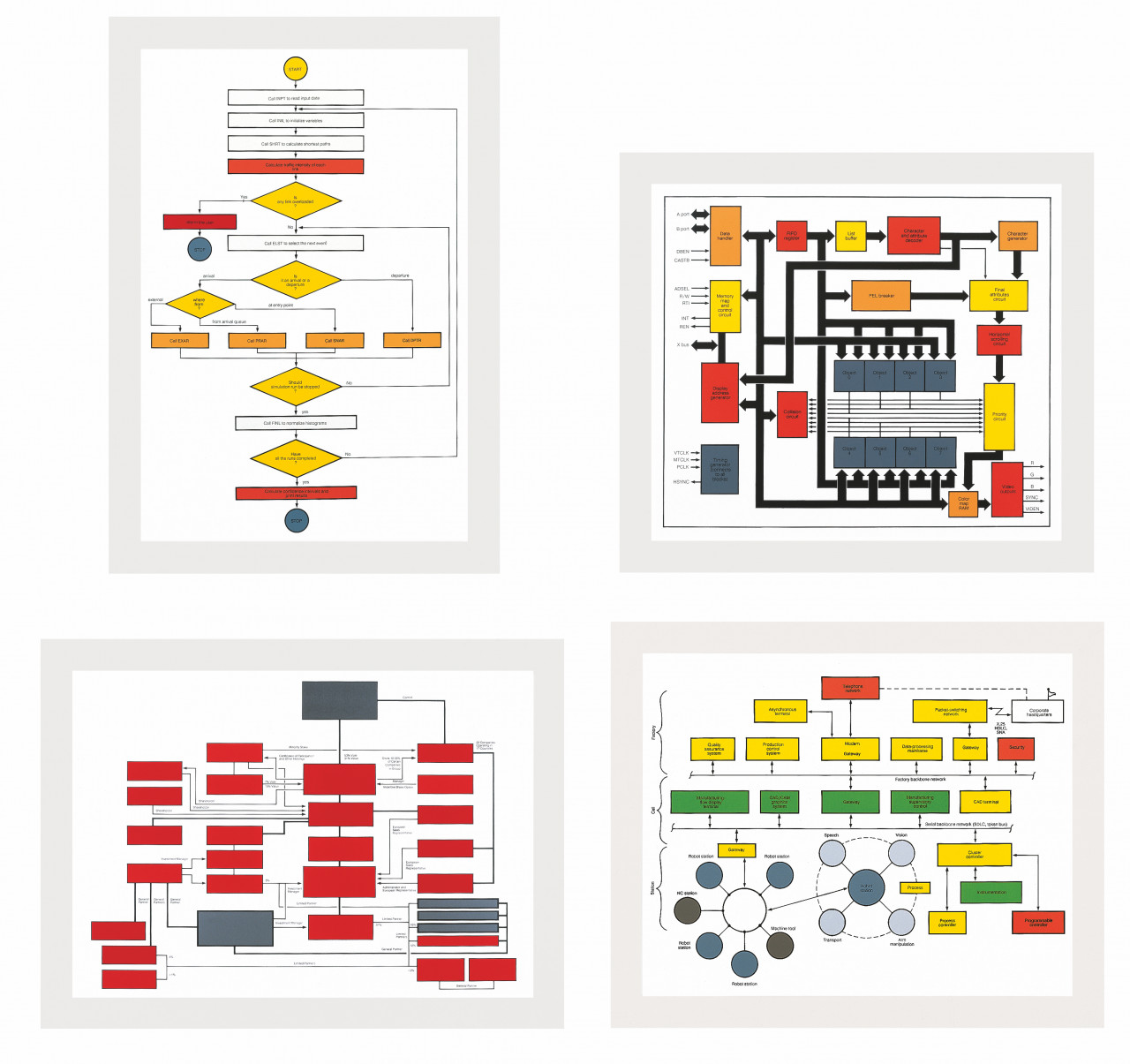Duality – Introducing Table Tableau
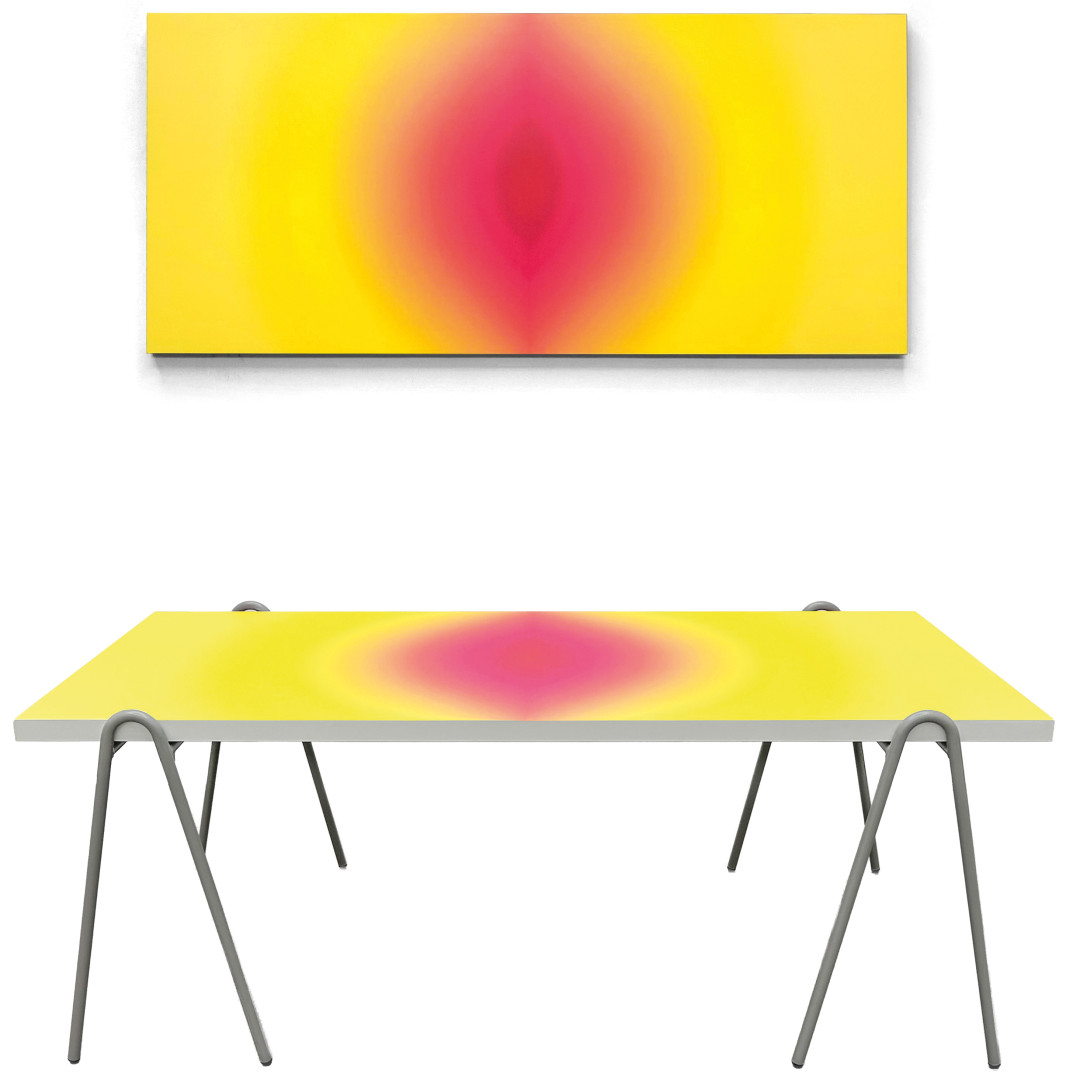
Table Tableau is a new series of large-scale editions that brings together ten contemporary artists to explore the artwork as both table and tableau. Rooted in the historical practice of painting on wooden boards – centuries before canvas became standard – the project foregrounds the wooden board as a shared material form, linking the painted panel and the tabletop. This material lineage, together with the shared etymological roots of table and tableau, underscores the intimate relationship between the everyday surface and the pictorial representation. Each artist was invited to create a high-pressure laminate (HPL) work on a wooden board, conceived to exist in two orientations: resting on trestles as a functional tabletop or hanging on the wall as an artwork. In moving between these modes, the works oscillate between utility and display, reclaiming the board as both support and surface, structure and image.
The project evolved from a 2019 collaboration marking the 100th anniversary of Thonet, the pioneering furniture manufacturer whose innovations remain central to modern design. While some artists have created works that fluidly slip between wall and floor, others emphasize the conditions that determine their form and use. Together, these editions expand traditional notions of authorship and reproducibility, considering how art can inhabit and transform the spaces around it – whether on the wall, in the room, or in everyday life.
J O H N A R M L E D E R
For Untitled (Thonet), John Armleder distills his signature dot motif into a sleek, industrially produced surface – one that can be encountered equally as table or tableau. Executed in black-on-white and white-on-black HPL, respectively, the work transforms serial patterning into an adaptable field that shifts character with orientation and use. Its grid of disciplined circles evokes the histories of Minimalism and geometric abstraction, yet here those references slip fluidly into the language of furniture, décor, and everyday life. In this translation from painted gesture to precision HPL, Armleder underscores the productive tension between object and image, uniqueness and repetition, offering a concise reflection on how art might inhabit and redefine the spaces it enters.
From Table Tableau
Laminate (HPL) on wooden board (black on white or white on black), 200 x 90 x 4 cm, to be used as a table top on trestles or hung on a wall in horizontal or vertical orientation. Edition of 30 + 3 A.P., with a signature label affixed verso and a signed and numbered artist’s certificate.
EUR 8,000

In this related canvas work, Armleder engages his emblematic dot motif through the directness of acrylic on canvas. Presented in two chromatic variations – white on gold and gold on white – the compositions echo the inversions and serial logic of his HPL piece, yet offer a distinctly different encounter. The hand-painted surface introduces a subtle vibration that shifts the work from industrial precision toward a more pictorial register, foregrounding color as atmosphere rather than finish. In dialogue with its HPL counterpart, the canvas underscores Armleder’s fluid movement between mediums and modes of production, invoking both the legacies of Minimalism and the decorative while inviting us to consider how materiality shapes the act of looking.
From Table Tableau
Acrylic paint on canvas, 200 × 90 x 4 cm (79 x 35.4 x 1.6 in). Edition of 5 painted in acrylic in white on gold and 5 painted in gold on white, signed and numbered on accompanying artist's certificate.
EUR 15,000

D A N I E L B U R E N
Daniel Buren expands the premise of Table Tableau from the single hybrid object to a dynamic, site-responsive system. Known for eschewing conventional “painting” in favor of works that situate themselves within and respond to their surroundings, Buren activates the project through an in situ approach that deploys the tabletop as both material and structural device. His contribution unfolds in two formats: a wall installation and a set of individual tabletops. Throughout, Buren continues to treat context and architecture as integral to the work, using his characteristic 8.7-cm stripe to investigate how visual structures shape perception.
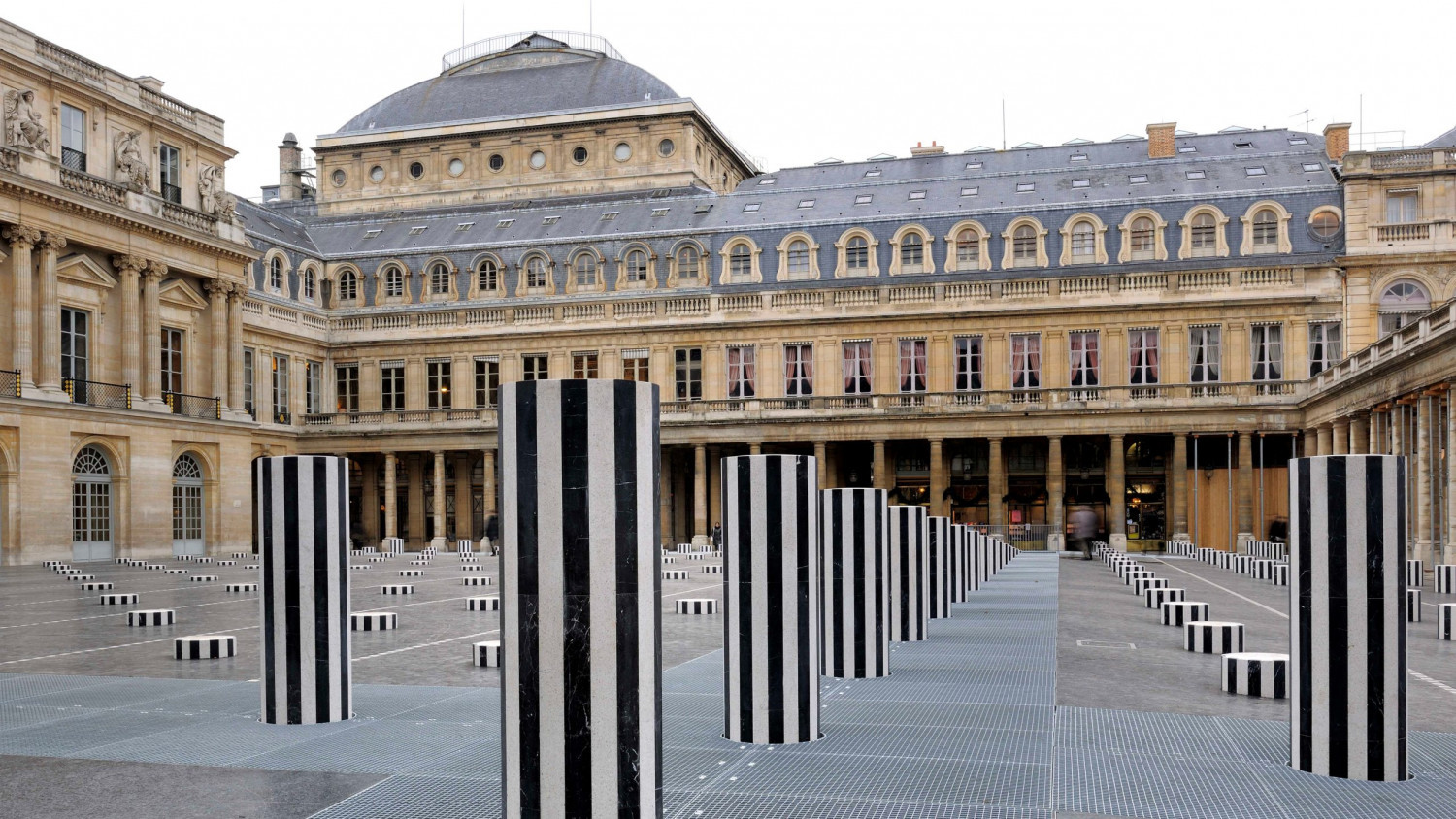
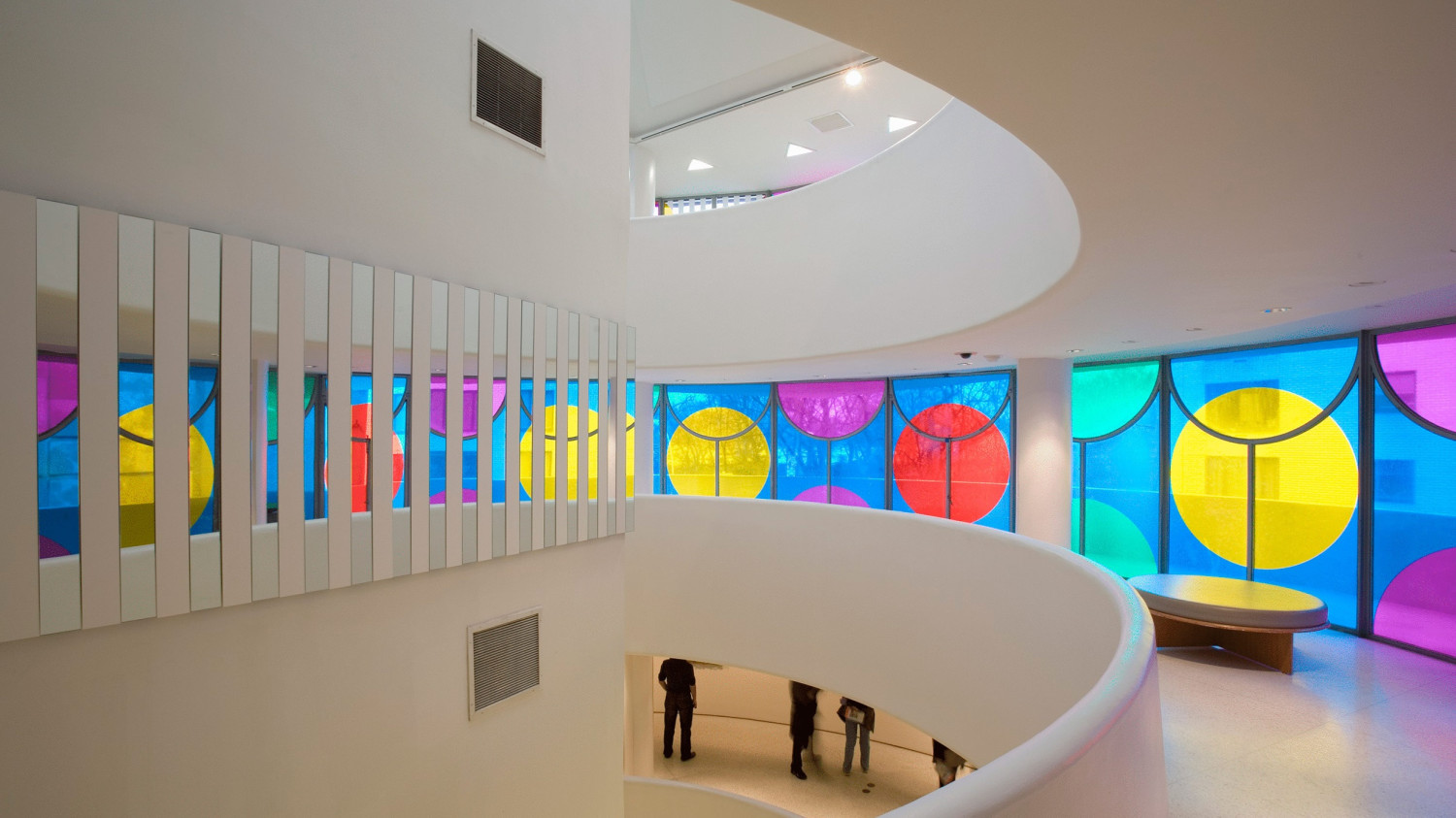

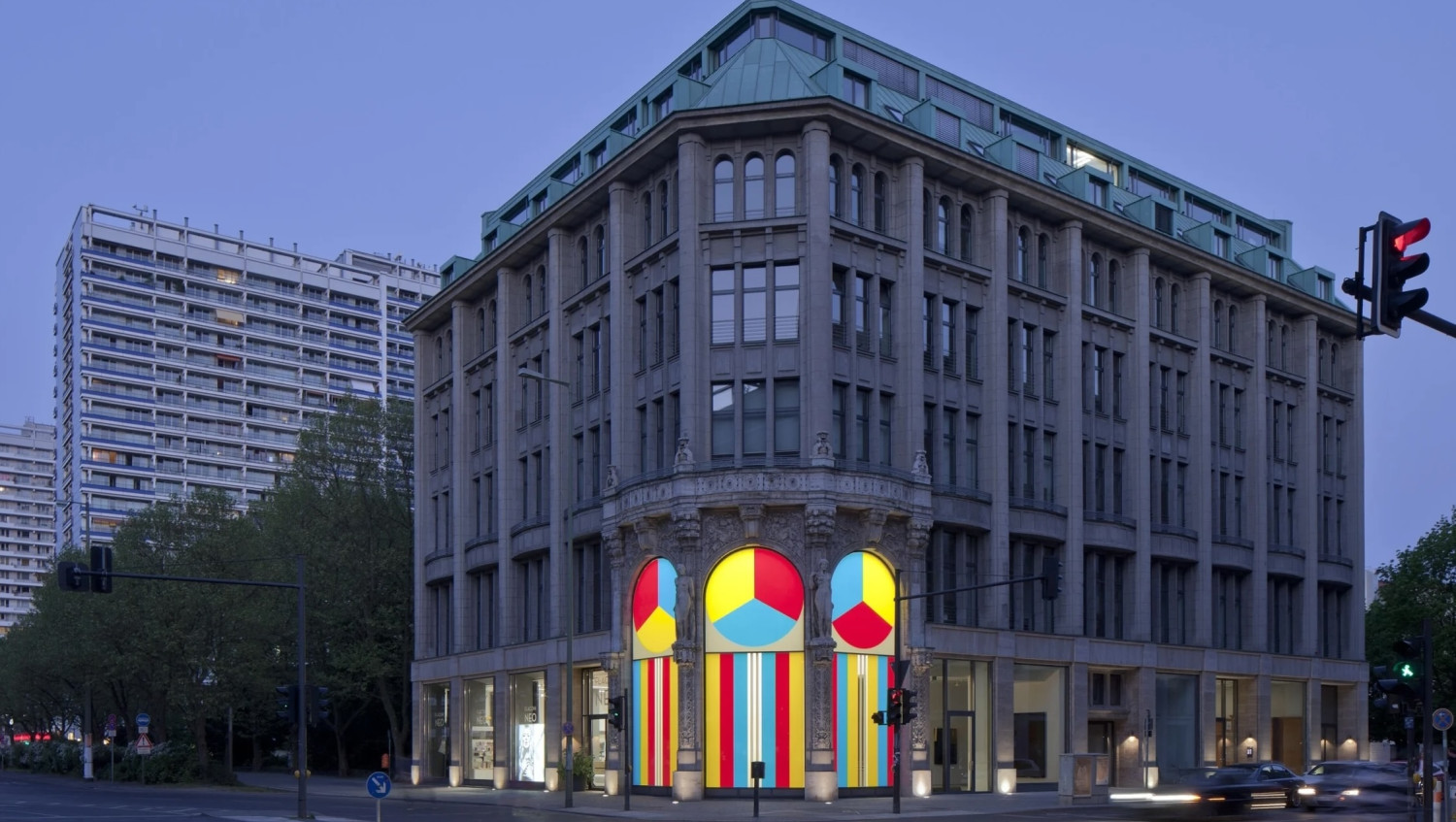
1. Les Deux Plateaux, permanent installation in situ, Cour d'Honneur du Palais Royal, Paris, 1985–1986 | 2. Color, Rhythm, Transparency – The Double Frieze, work in situ, in “The Eye of the Storm”, Solomon R. Guggenheim Museum (Thannhauser Gallery 3), New York, 2005 | 3. Three-coloured fountain walls for a hexagon, work in situ, Pistoia, Italy, 2005–2011 | 4. Triptych: a work in situ, Galerie Thomas Schulte, Berlin, 2016
For the wall installation, three HPL tabletops – each defined by a distinct geometric motif and RAL-specified color – are mounted within a visibly drawn grid. Their positions may be freely arranged in any horizontal orientation or configuration, inviting spatial play and interpretive flexibility. The grid becomes both framework and field, binding wall, surface, and object into a shared visual plane. By shifting from potential furniture to modular wall composition, the work foregrounds the conditional nature of display and underscores how placement and orientation actively shape meaning.
From Table Tableau
Installation of three table tops (HPL coated wooden boards), 95.7 x 200.1 x 4.35 cm each; to be installed within a grid drawn on a wall according to the artist’s instructions. Edition of 15 (+ 2 A.P.) unique three-part works, stamped and numbered by the artist on the accompanying artist’s certificate.
EUR 28,000
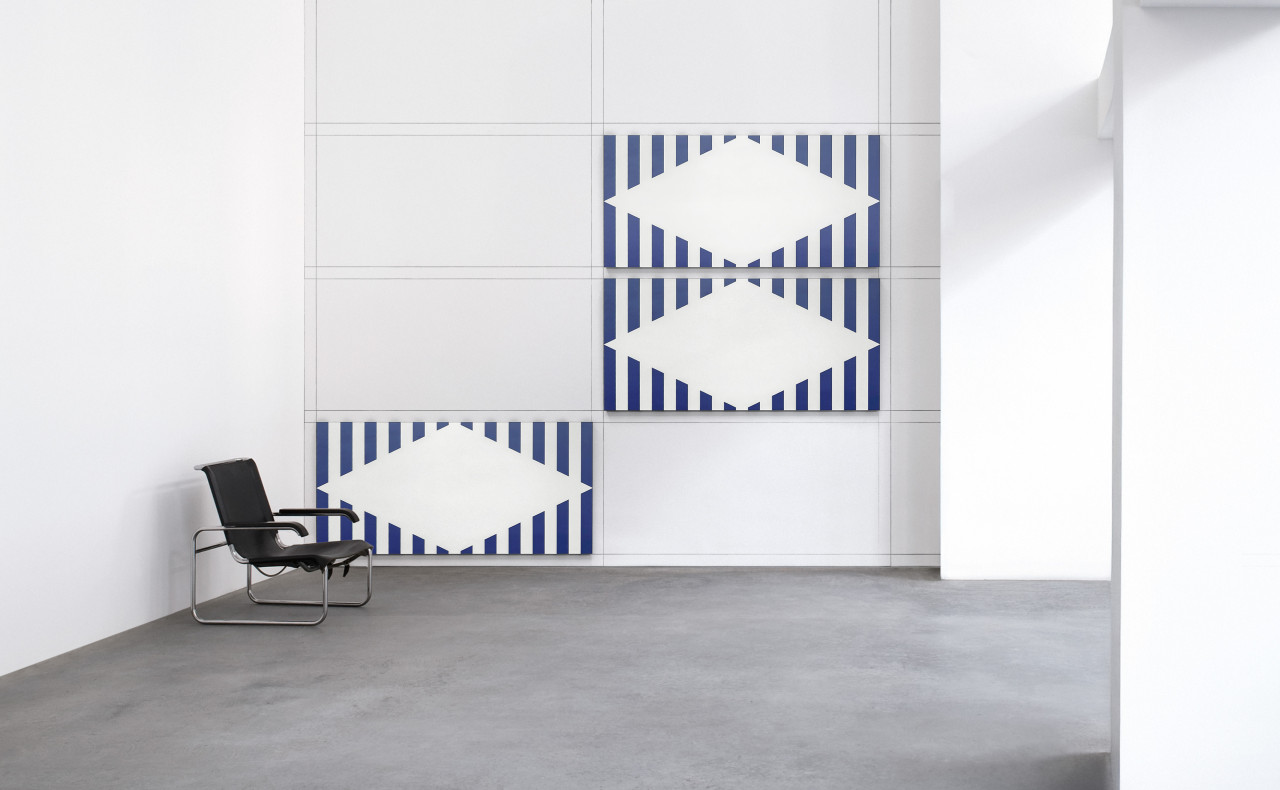
This inquiry extends to Buren’s tabletops conceived for Table Tableau, which translate his formal vocabulary into the realm of active use. Each HPL-coated board presents a unique geometric configuration and color, transforming the horizontal surface into a pictorial field. While intended to rest on trestles as functional objects, these pieces retain the clarity and rigor of Buren’s visual language – most notably the precise stripe, operating as both structure and sign. In dialogue with the wall installation, the tabletops reveal how context directs perception, moving fluidly among furniture, image, and architecture.
From Table Tableau
Table top. HPL coated wooden board, 95.7 x 200.1 x 4.35 cm, to be placed on trestles. Edition of 15 (+ 2 A.P.) unique works, stamped and numbered by the artist on the accompanying artist’s certificate.
EUR 9,000

P E T E R H A L L E Y
Peter Halley has long explored the visual language of modern systems through his distinctive geometry of cells and conduits. Since the 1980s, these forms have served as metaphors for the networks and enclosures that shape social and architectural space, mapping both connection and isolation within the built environment.
Further examples of Halley’s sustained exploration of cells and conduits over several decades:
For Table Tableau, Halley adapts his signature geometric vocabulary to the hybrid format, merging artwork and utilitarian object. The interlocking bands that traverse the surface of Serpentine Table echo his signature structures – abstract systems that articulate both movement and containment. Realized in mauve pink or gray HPL, the composition maintains Halley’s characteristic clarity while proposing a more immediate dialogue with everyday space. Whether placed on trestles or mounted on the wall, the work continues the artist’s investigation into the intersections of structure, system, and social space – inviting a reconsideration of how an image can function, and where it might belong.
From Table Tableau
Laminate (HPL) on wooden board (in mauve pink or gray), 90 x 200 x 4 cm, to be used as a table top on trestles or hung on a wall in horizontal orientation. Edition of 30 + 3 A.P., with a signature label affixed verso and a signed and numbered artist’s certificate.
EUR 8,000

K E I T H H A R I N G
This tabletop translates one of Keith Haring’s iconic all-over compositions into a vibrant, usable surface. The dense network of interlocking lines and figures – rendered in striking black and white – channels the immediacy and graphic pulse central to Haring’s visual language. By shifting from painting to HPL, the work brings his energetic forms into everyday circulation, echoing the artist’s long-standing commitment to accessibility and the merging of art with daily life. As both functional object and pictorial field, the tabletop underscores Haring’s belief that art can move fluidly across contexts, inviting open engagement wherever it appears.
From Table Tableau
Laminate (HPL) on wooden board, 90 x 200 x 4 cm, to be used as a table top on trestles. In black on white or white on black. After a painting by Keith Haring, licensed © 2019 by the Keith Haring Foundation. Edition unsigned and unlimited, numbered on the accompanying publisher’s certificate.
EUR 8,000

A N I S H K A P O O R
With Fold, Anish Kapoor brings one of his signature spatial illusions to the hybrid format of Table Tableau. A radiant gradient of yellow sinking into deep red appears to recede into the surface, creating an optical fold that evokes depth and interiority. This subtle yet powerful manipulation of color animates the board whether presented horizontally on trestles or mounted on the wall, inviting viewers to contemplate the instability of surface and perception. In oscillating between object and image, utility and artwork, Fold extends Kapoor’s exploration of immaterial space – where what is seen seems always to open onto something beyond.
From Table Tableau
Laminate (HPL) on wooden board, 90 x 200 x 4 cm, to be placed on trestles or hung horizontally on the wall. Edition of 30 + 6 A.P., signed and numbered on label affixed verso.
EUR 30,000
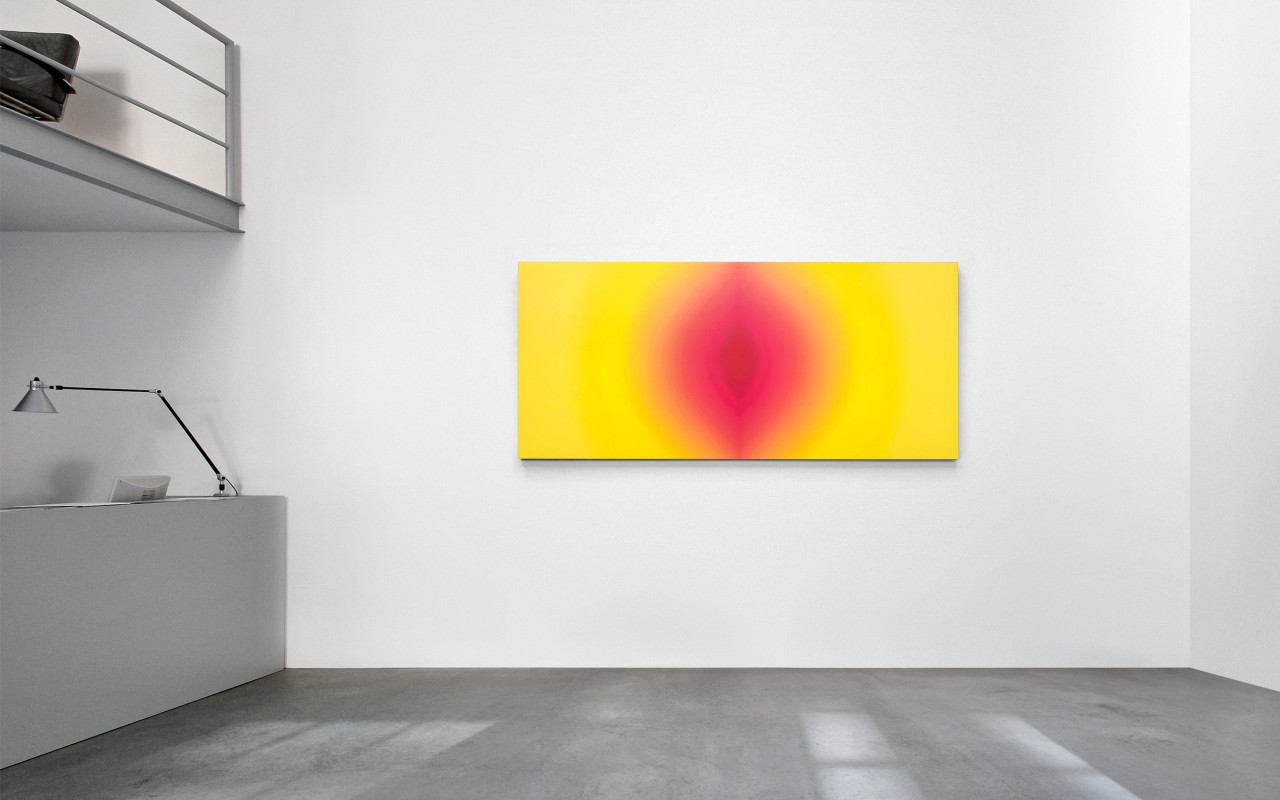
J O S E P H K O S U T H
A pioneer of Conceptual Art, Joseph Kosuth has spent more than five decades examining the structures through which meaning is produced. His practice centers on language as both medium and subject, probing the relationship between words, objects, and ideas. This line of inquiry was crystallized in his seminal One and Three works of the mid-1960s, in which an object was presented in tandem with its photographic image and dictionary definition.

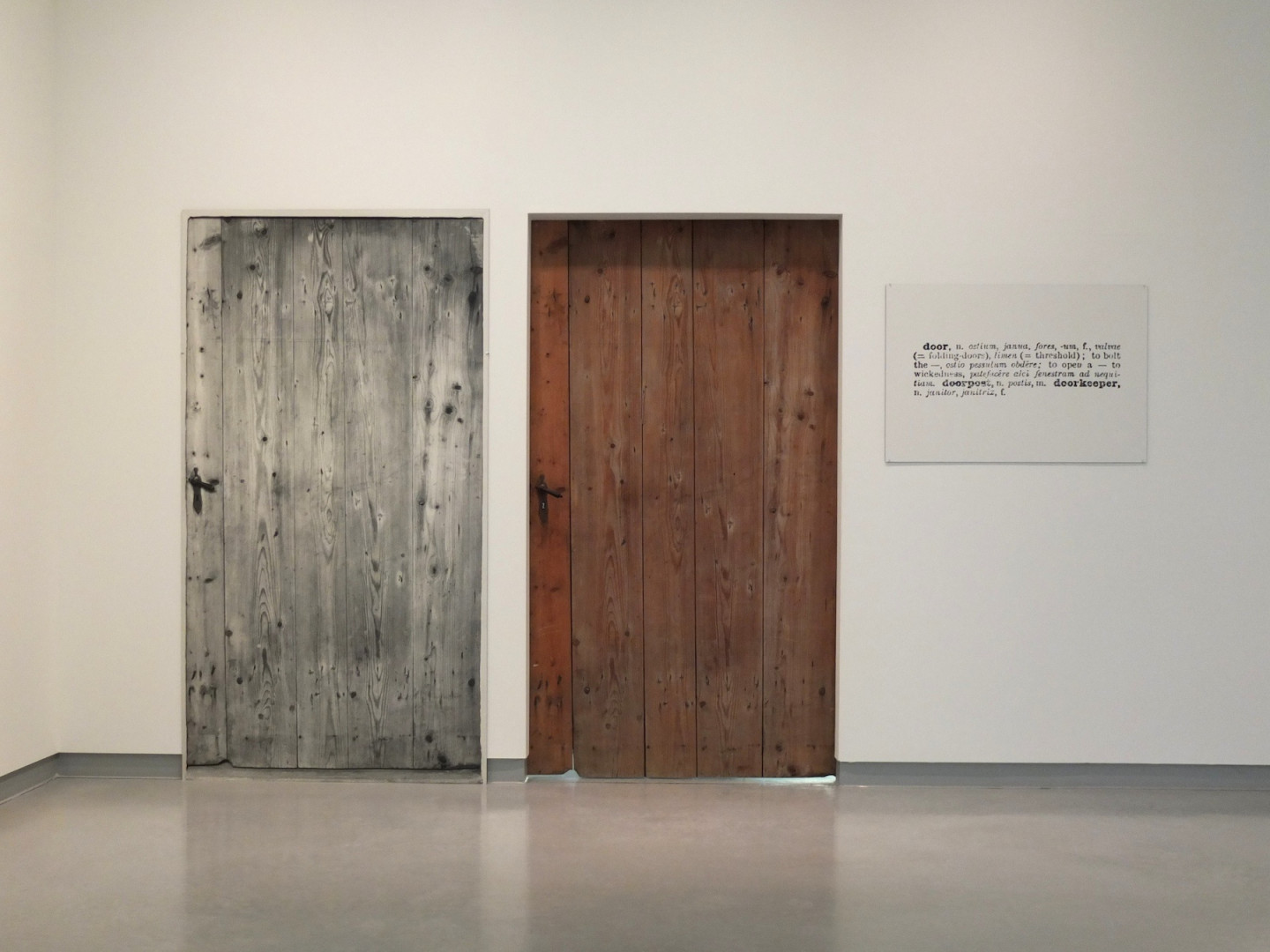
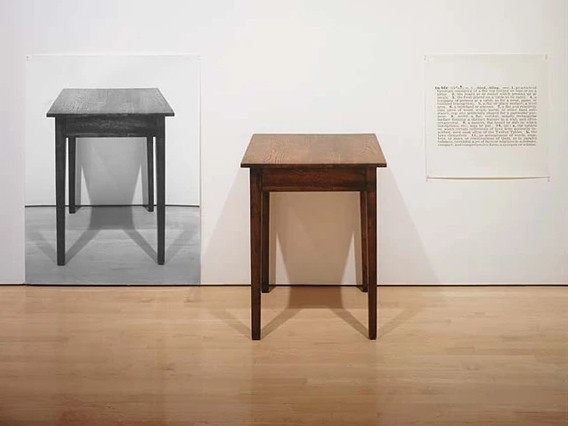
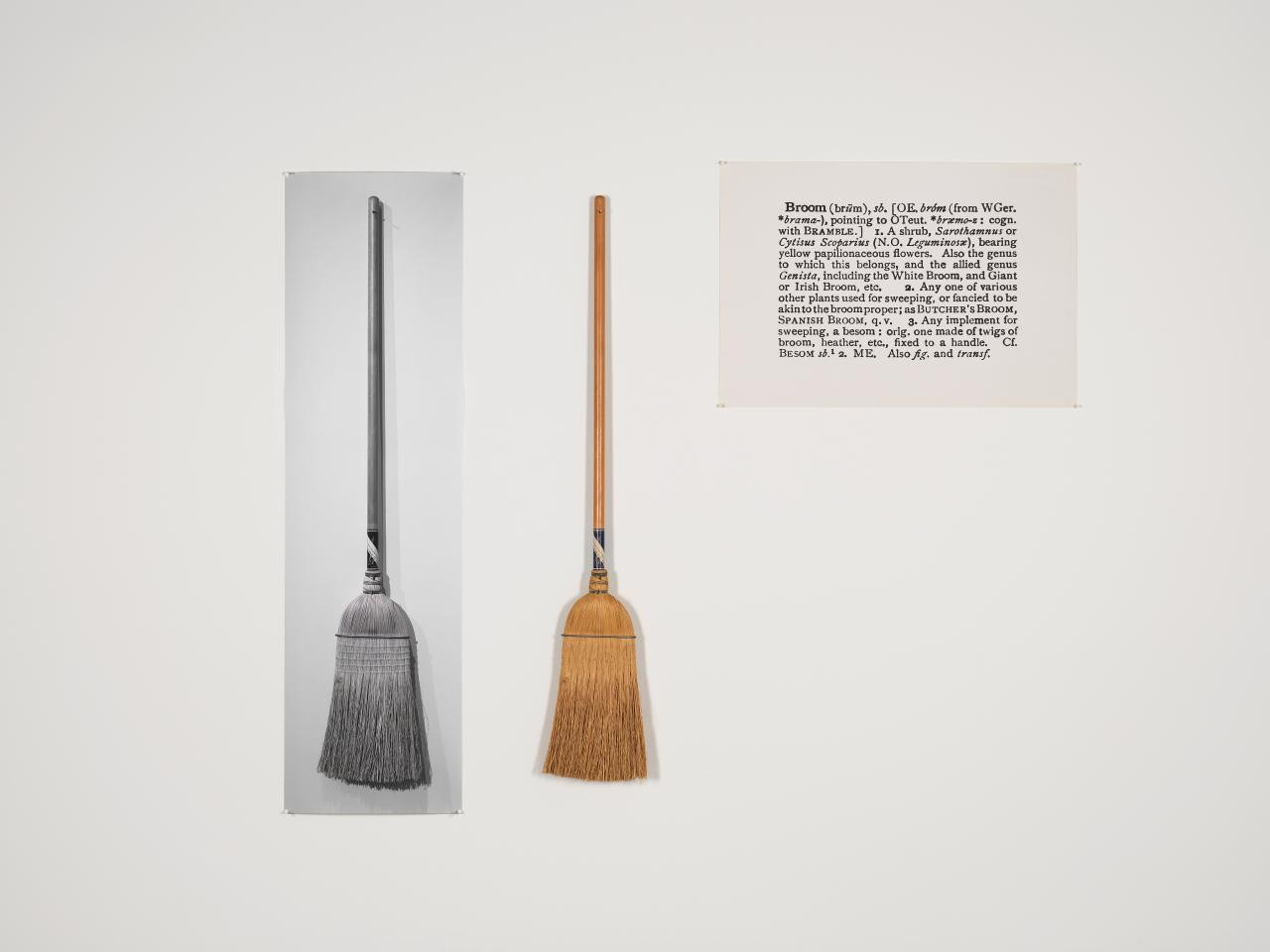
1. One and Three Chairs, 1965 | 2. One and Three Doors, 1965 | 3. One and Three Tables, 1965 | 4. One and Three Brooms, 1965
Kosuth adapts this methodology to the framework of Table Tableau in ‘Table, Tabula’ [Table Format], foregrounding language as the core of the work. A dictionary definition of the word “table” is presented and overlaid with a photograph of the corresponding tabletop – an arrangement that directly echoes the conceptual triangulation of object, image, and text central to One and Three. By collapsing representation and referent, the work exposes how linguistic and visual systems shape – and destabilize – the ways objects signify. Presented horizontally on the wall, the piece reflects on how language structures the everyday while also embodying the paradox of an artwork that is both about a table and visually functions as one.
From Table Tableau
Laminate (HPL) on wooden board, 90 x 200 x 4 cm, to be hung horizontally on the wall. Edition of 15 + 2 A.P., signed and numbered on the accompanying artist’s certificate.
EUR 8,000
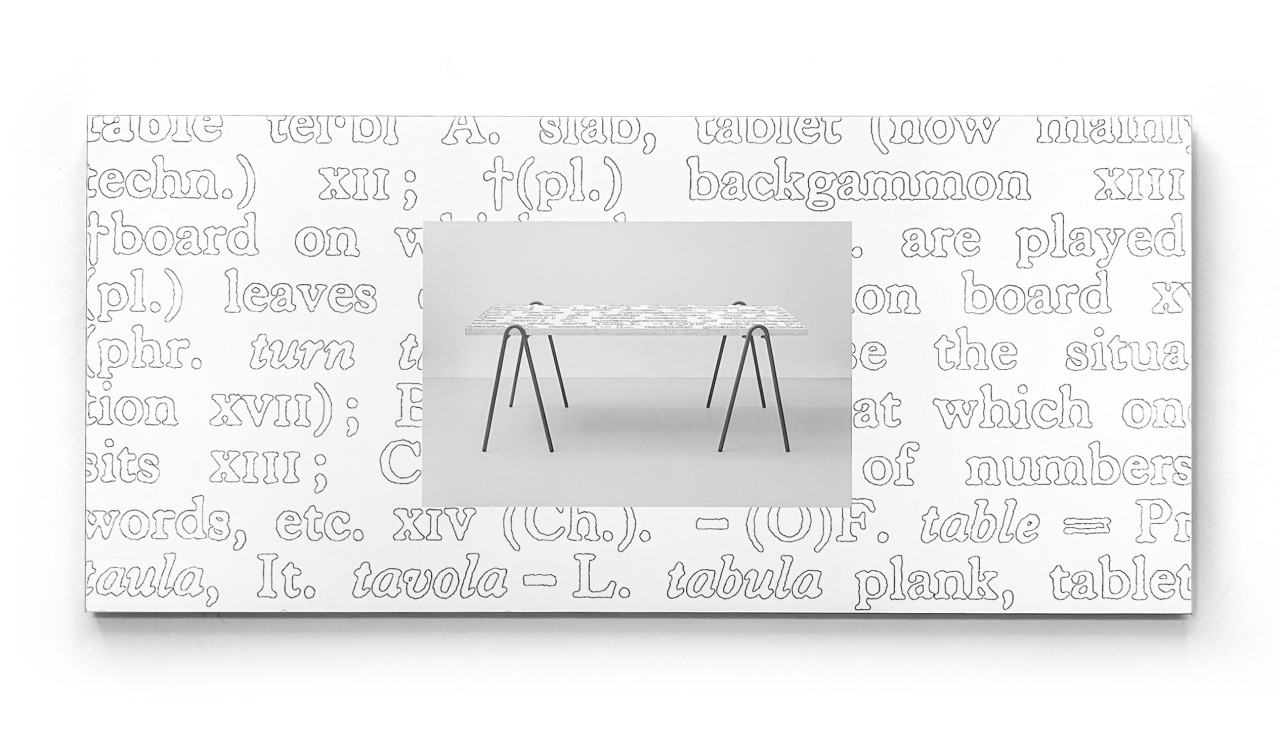
The second iteration, ‘Table, Tabula’ [Table Top], narrows the focus to the textual register alone. Its surface reproduces the same dictionary definition, but omits the photographic image present in the wall work. Designed to rest on trestles as a functional surface, the piece occupies a liminal position between object and statement, pointing simultaneously to the table as physical support and linguistic construct. This convergence of use-object and text extends Kosuth’s foundational inquiry into how meaning is produced – here realized as a table that does not depict, but defines.
From Table Tableau
Laminate (HPL) on wooden board, 90 x 200 x 4 cm, to be placed on trestles (model as illustrated). Edition of 15 + 2 A.P., signed and numbered on the accompanying artist’s certificate.
EUR 8,000
+ EUR 1,500 for the trestles
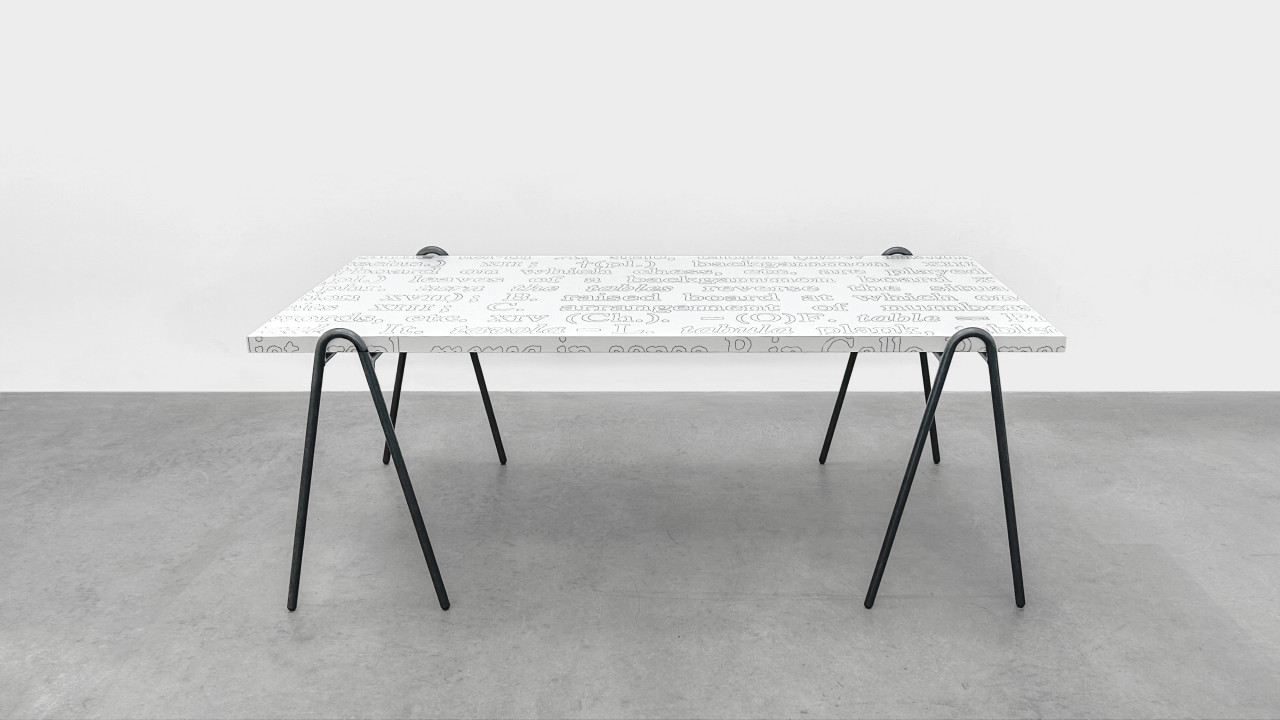
S A R A H M O R R I S
Aggressivity and Thinking brings the visual logic of Morris’s Sound Graphs into the vertical proportions of Table Tableau. Bands and circular elements – based on the spectrogram of a conversation – appear to pulse across the surface, forming a coded abstraction that hints at underlying structures without revealing them outright. The print’s layered geometry and saturated palette evoke a sense of movement and vibrancy, drawing the viewer into a space where information and image seem to overlap. By invoking systems of notation while remaining resolutely non-narrative, Morris collapses distinctions between seeing and interpreting, offering a work that feels at once analytic and sensorial.
From Table Tableau
Silkscreen of six colors and varnish on Somerset Tub 410 gsm paper, 200 x 90 cm. Edition of 15 + 3 A.P., signed and numbered on label verso.
EUR 12,000

T O B I A S R E H B E R G E R
With Not always but better, Tobias Rehberger brings his interest in optical play and spatial ambiguity to the dual format of table and tableau. Across the surface, a dynamic field of repeating geometric forms and sharply contrasting colors generates a pulsing visual effect that appears to expand and contract as one moves around it. This shifting perceptual ground complicates the work’s status as a functional object, transforming it into an active site of sensory experience. Whether hung on the wall or set on trestles, the piece underscores Rehberger’s ongoing engagement with how design, ornament, and perception intertwine to challenge the viewer’s sense of orientation.
From Table Tableau
Laminate (HPL) on wooden board, 90 x 200 x 4 cm, to be used as a table top on trestles or hung on a wall. Edition of 30 + 3 A.P., with a signature label affixed verso and a signed and numbered artist’s certificate.
EUR 8,000

T H O M A S R U F F
Thomas Ruff translates one of his digitally generated line compositions into a dual object in Zycle (Thonet). Derived from illustrations of magnetism, the line configurations suggest planetary orbits, abstract linear drawing, or musical oscillation. Fine, sweeping curves intersect across the surface, evoking trajectories through an implied three-dimensional space.
Rendered in inverse black-on-white or white-on-black versions, the work extends Ruff’s investigation into the relationship between technological image production and perception, shifting from screen-based abstraction to a tangible, architectural plane. Whether resting on trestles or mounted horizontally on the wall, Zycle (Thonet) draws attention to how context and orientation shape the experience of an image.
From Table Tableau
Laminate (HPL) on wooden board, 90 x 200 x 4 cm, to be used as a table top on trestles or hung on a wall. Two color versions: black on white or white on black. Total edition of 40 + 4 A.P., with a signature label affixed verso and a signed and numbered artist’s certificate.
EUR 8,000

Other works from Ruff's zycles series:
Set of 3 digital pigment prints (Ditone) on photo rag paper, 85 x 68 cm (33½ x 26¾ in) each. Edition of 30, each signed and numbered on verso.
Set EUR 6,000
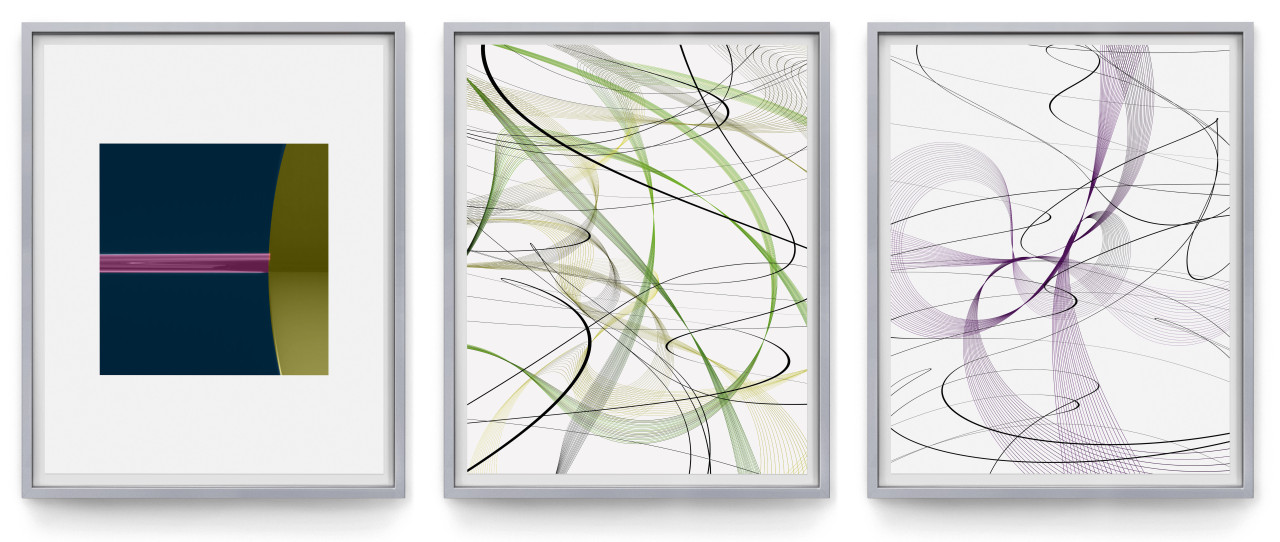
Set of three digital pigment prints (Ditone) on semi-transparent polyester foil; left and right image 100 x 76.7 cm each, center image 100 x 80 cm (39½ x 30¼ or 39½ x 31½ in). Edition of 15, each signed and numbered.
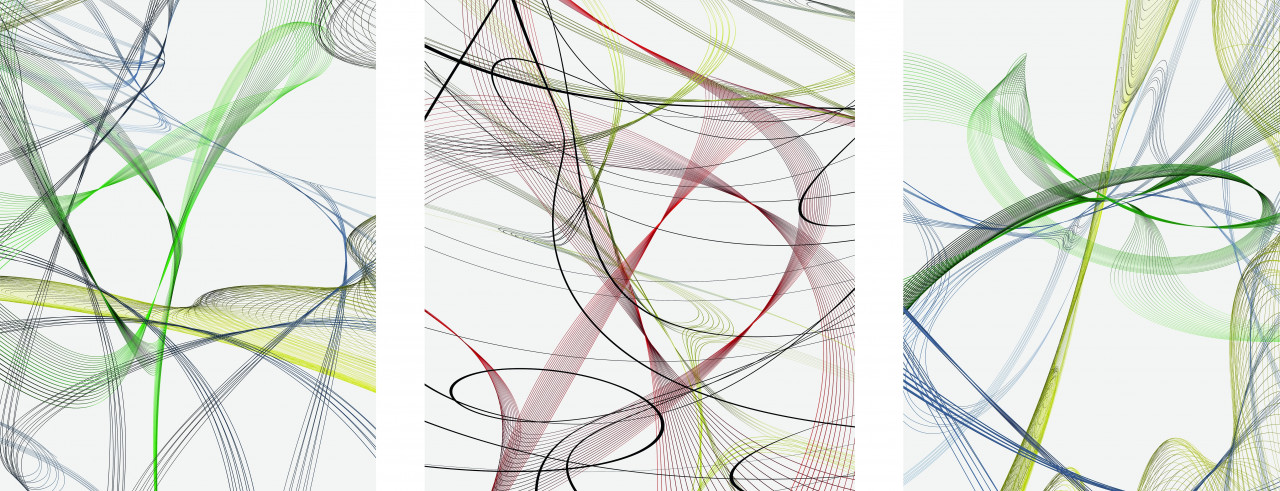
R O S E M A R I E T R O C K E L
In DINING Table, Rosemarie Trockel approaches the tabletop as a conceptual diagram. Sparse linear markings articulate proportional relationships, converting both metric and imperial units of measurement into visual form. These calibrated traces suggest a space where planning, calculation, and imagination meet. At once pragmatic and abstract, these notations transform the board into a field of potential actions rather than a fixed image. The title’s wry nod to “DIN” gestures toward standardization, yet the work resists becoming purely instructional; instead, it questions how systems of measurement structure both form and thought. Positioned on trestles or hung on the wall, DINING Table invites viewers to consider the meeting point of order, use, and artistic speculation.
From Table Tableau
Laminate (HPL) on wooden board, 90 x 200 x 4 cm, to be used as a table top on blue trestles (model as illustrated) or hung on a wall in horizontal orientation. Edition of 30 + 3 A.P., with a signed and numbered artist’s certificate.
EUR 8,000 (+ EUR 1,500 for the trestles)

Taken together, the works in Table Tableau expand the ontology of the editioned artwork. By treating the table as both a practical surface and a pictorial subject, the participating artists explore the material, linguistic, and spatial systems through which meaning takes shape. The project foregrounds questions of orientation, reproducibility, and context, showing how shifting modes of display generate new interpretations. Ultimately, these works reveal the table as a site of duality – a conceptual hinge between function and symbol, object and image, the domestic and the institutional.
